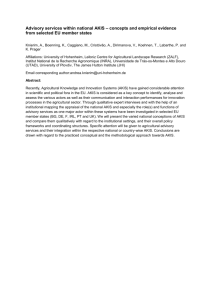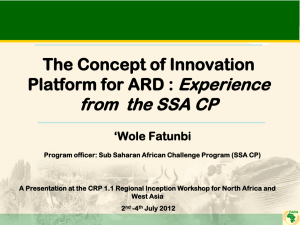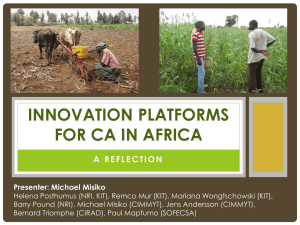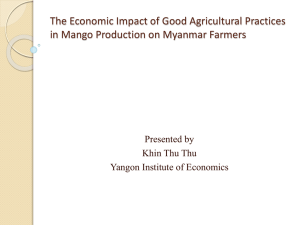Anne Vuylsteke Experiences with interactive - ARD
advertisement
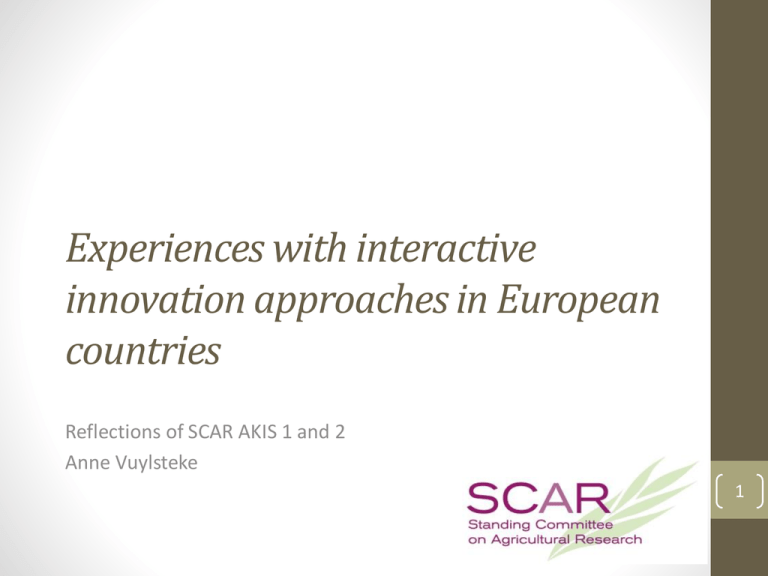
Experiences with interactive innovation approaches in European countries Reflections of SCAR AKIS 1 and 2 Anne Vuylsteke 1 Content • Background of SCAR AKIS strategic working group • AKIS concept • Experiences with interactive innovation approaches • Conclusions 2 Background of the SCAR AKIS strategic working group • Standing Committee on Agricultural Research (1974, renewed 2005) • Drivers for a working group on Agricultural Knowledge and Innovation Systems (AKIS) • 2006, Krems: request to include advisory services, education, training and innovation • 2008, Communication “Towards a coherent strategy for a European Agricultural Research Agenda”: use SCAR to identify agricultural knowledge structures in each MS • SCAR foresight • 1st (2007): call for a review of the links between knowledge production and its use to foster innovation • 2nd (2009): agricultural knowledge systems unable to absorb and internalise the fundamental structural and systemic shifts that have occurred 3 Background of the SCAR AKIS strategic working group • 2009: start of the working group • Collaborative working group AKIS 1 and 2: chaired by NL and FR • Strategic working group AKIS 3: chaired by NL and BE • Working method • A network of civil servants and researchers from the Member States and the European Commission • No budget, except for some studies in collaboration with EU projects • Reports • AKIS 1 (2012): Agricultural Knowledge and Innovation Systems in Transition – a reflection paper • AKIS 2 (2013): Agricultural Knowledge and Innovation Systems towards 2020 – an orientation paper on linking innovation and research 4 AKIS Concept • AKIS … • • • • exist are quite different between countries / regions were restructured considerably in some countries are governed by public policy but consistent overarching AKIS policies are not apparent • AKIS components are governed by quite different (and sometimes conflicting) incentives 5 AKIS Concept within the food chain 6 AKIS Concept 7 functions of knowledge and innovation systems: 1. 2. 3. 4. 5. 6. 7. Knowledge development and diffusion Influence on direction of search and identification of opportunities Entrepreneurial experimentation and management of risk and uncertainty Market formation Resource mobilisation Legitimation Development of positive externalities (c) M. Hekkert et al. Science versus innovation driven research Aspect Science driven research Innovation driven research Incentive to program a topic Emerging science that can contribute to solving a societal issue (or a scientific question) In demonstration phase / via research dissemination Scientific quality Research organisations Linear model Science / Research Policy An issue / problem in society that can be solved by new research, or a new idea to solve an existing issue In agenda setting, defining the problem and during the research process Relevance (for the sector or a region) Networks of producers and users of knowledge System (network) approach Innovation Policy Participation of users Quality criteria Focus Diffusion model Type of government policy Economic line of thinking Macro-economics Finance The role of the EU Typical EU examples Type of research Systems of innovation To a large extent public money: more Public-private partnerships very possible speculative and large spill over effects / advantageous Efficiency of scale (member states often too small), smart specialisation between member states, create European research market with harmonisation of hard- and soft infrastructures Horizon 2020, FP7, ERC, some ERAnets, Joint Programming Initiatives Interdisciplinary with absorption capacity in AKIS (to work with material science, ICT, chemistry etc.). Stimulate interaction and learning in Europe between national/regional AKIS. Enable in CAP innovation by networks with farmers CAP: European Innovation Partnership, LEADER, European Technology Platforms, 8 EIPs, some ERAnets Transdisciplinary and translational with close interactions. Experiences with interactive innovation approaches • Innovation as a process has strong learning aspects: learn how to do new things, bottom-up • Alternative: force (or pay for) quality standards, mandates • Thematically-focused learning networks of different actors can help • Generating learning and innovation through interactions between the involved actors • Members can include farmers, extension workers, food industry, researchers, government and ngo representatives and other stakeholders 9 Experiences with interactive innovation approaches • The European perspective of the European Innovation Partnership (EIP) “Agricultural productivity and sustainability” • Operational groups, thematic networks, multi-actor projects • Co-creation and cross-fertilisation as keywords Farmers NGOs Agribusiness Advisors Operational Group Researchers "Operational Groups" are no stakeholder networks, no stakeholder boards, no thematic coordination groups, nor discussion groups An OG = actors working together in a project targeted at innovation and producing concrete results 10 Experiences with interactive innovation approaches • Incentives for coordination between AKIS subsystems • • • • • Agreenium (France) Innovation Network (the Netherlands) European Technology Platforms Floriculture technology and Innovation Network (Belgium) Agricultural Research Advisory Board (Turkey) • Examples of interactive innovation approaches – programs • RMT + Innovation and Partnership projects - CASDAR (France) • Better Farm Programme (Ireland) • LINK programs (UK) 11 Experiences with interactive innovation approaches • The example of CASDAR • Funded by the sector, managed by the ministry • 2 examples of tenders • Joint Technological Network • Strengthen interactions of actors in development, research and education to promote innovation and knowledge transfer (since 2006) • Basic and applied research institutes, education, advisors and various development actors • Work around themes of common interest and strong challenged for the sector • RMT propose concrete interactive innovation projects • Innovation and partnership projects • Mobilize stakeholders in agricultural and rural development on applied research and innovation actions • Produce operational results in a user-friendly way to farmers and to have an adequate partnership for the project work • Conducted in partnership between development and advisory services, research and training agencies, including groups of farmers 12 Experiences with interactive innovation approaches • Examples of interactive innovation approaches – projects • KarkaKompassi (Cow Compass, Finland) • Improve the quality of Danish beans by heat treatment (Denmark) • Control of the Mediterranean Fruit Fly (Spain) • Riduca reflui (Italy) • Organic Farmers’ Networks (Belgium) • Farmersandclimate.nl network (the Netherlands) • Good Fruit (Estonia & Latvia) • Système Terre et Eau 13 Experiences with interactive innovation approaches • The example of organic farmers’ networks • One pillar of the Flemish Organic Research & Knowledge Network • Characteristics • 7 farmers’ networks: dairy cattle, beef cattle, vegetable & arable crops, goats, poultry, berries and greenhouse crops • Coordination by BioForum, the sector organization of the organic sector in Flanders • Close cooperation with different actors and networks • Topics are all farm-related ( technical, marketing related) • Process 1. 2. 3. 4. 5. 6. 7. Problem setting Asking the right questions, relating to existing knowledge, relating to individual problems what is needed to tackle the problem? Co-creation funding project idea Working together to tackle the problem and disseminating interim and final results Evaluation and further steps to take Taking it further 14 Experiences with interactive innovation approaches • Lessons learned • Drivers or motivations at the start differ • Problem, risk or challenge, need, opportunity, strategic (policy) choice • Key success factors • • • • • • Composition of the group and way of working Facilitation Outcomes Framework conditions Availability of tools and learning methods Appropriate funding model (public and private) • Good experiences with cross-border collaboration But often not easy to realize 15 Conclusions • Several elements are needed to come to a policy that stimulates interactive innovation: • Incentives for research, development and innovation • Stimulation of knowledge exchange, adoption of innovation, technical application in the production process; • Support to the activities of facilitators, innovation brokers and tutoring paths for farmers to implement innovations; • Valuation of the input and knowledge of farmers; • Stimulation of cross-border interactions; • Investment in AKIS-subsystems that have been underdeveloped • Special attention is needed to incentivize research to be responsive to the needs of innovation processes • More can be done than research to promote innovation • EU market for research and innovation to stimulate cross-border cooperation 16
